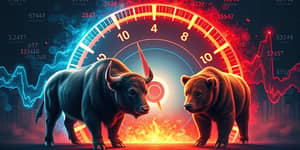
Financial markets move through cycles of optimism and caution, reflecting the delicate balance between growth pursuits and preservation instincts. The concept of Risk-On/Risk-Off (RORO) captures this ebb and flow, tracking how capital shifts in search of higher returns or greater safety. By understanding the underlying forces, historical patterns, and practical strategies, investors can navigate these swings with greater confidence and clarity.
This article unpacks the anatomy of RORO phases, explores the drivers behind sentiment shifts, and equips readers with tools for aligning portfolios with market moods. Drawing on real-world examples—from the 2008 financial crisis to the COVID-19 shock—it provides a comprehensive guide to one of the most fundamental dynamics in global investing.
At its core, risk-on signals periods when investors deploy capital into assets with the potential for higher returns. These phases are characterized by strong risk appetite, buoyed by encouraging economic data, supportive monetary policy, or positive geopolitical developments. Common targets include equities, commodities, and higher-return, riskier asset classes such as high-yield bonds or emerging market currencies.
Conversely, risk-off reflects a collective retreat toward safety. When uncertainty spikes or negative news dominates headlines, capital seeks refuge in assets perceived as resilient. Government bonds, cash, and gold serve as safe-haven assets, while the US dollar and Japanese yen often strengthen as global credit conditions tighten.
Multiple factors shape the RORO spectrum, often interacting in complex ways. Understanding these elements can help investors anticipate sentiment shifts rather than merely reacting to them.
This simple framework illustrates how capital rotates. During risk-on windows, investors chase growth; in risk-off retreats, they prioritize stability and liquidity.
The 2008 financial crisis stands as a dramatic example of a risk-off tsunami. Equities plunged, credit markets seized up, and there was a historic rush into US Treasuries and gold. Similarly, the onset of the COVID-19 pandemic in early 2020 triggered a sharp risk-off phase, with the S&P 500 dropping over 30% in a month while safe-haven assets surged.
Conversely, after central banks pivoted to ultra-dovish policies post-crisis, markets staged rapid risk-on rallies. These episodes underscore that no sentiment phase lasts indefinitely; policy actions, economic data, and investor psychology eventually swing the pendulum back.
Sentiment swings can occur within minutes, driven by headlines or high-frequency trading algorithms. Understanding the mechanics behind these moves is vital for risk management. Traders often employ stop-loss orders, option hedges, and diversification and portfolio hedging strategies to guard against sharp reversals.
Long-term investors, meanwhile, must balance tactical allocation with strategic targets. While it’s impossible to eliminate risk entirely, awareness of RORO cycles can guide periodic rebalancing—selling appreciated risk assets in frothy markets and buying quality holdings during widespread pessimism.
Several metrics serve as barometers for RORO conditions. Employing these tools can help investors align positions with prevailing sentiment rather than blindly following emotion.
Regularly monitoring economic calendars—Fed, ECB, and BOJ announcements, major earnings reports, and geopolitical developments—also helps anticipate key inflection points.
RORO dynamics are as much about human nature as they are about economics. Herd behavior amplifies both rallies and sell-offs: optimistic cycles foster fear of missing out, while negative spirals drive panic exits. By acknowledging the role of fear and greed cycles, investors can guard against emotional decision-making.
Disciplined investors develop rules-based approaches to counteract bias, such as committing to rebalancing on schedule or deploying predetermined hedges when volatility crosses certain thresholds.
Emerging research explores how AI and algorithmic trading systems forecast and respond to RORO states. These models analyze massive datasets—news sentiment, order flows, and social media chatter—to anticipate imminent mood swings. While quant tools can enhance timing, they also raise questions about feedback loops and the potential for self-reinforcing volatility spikes.
Institutions weigh long-term allocation goals against tactical overlays, blending strategic equity weights with dynamic risk-on/risk-off tilts. This hybrid approach aims to capture market upside while cushioning downside shocks.
Risk-On/Risk-Off cycles are an enduring feature of global markets, driven by economics, policy shifts, and human psychology. Identifying current market sentiment and understanding its catalysts can transform how investors allocate capital, manage risk, and pursue returns.
No phase lasts forever. By developing disciplined strategies, employing robust monitoring tools, and maintaining adaptability and situational awareness, investors can navigate mood swings more effectively—turning market turbulence into strategic opportunity.
References













